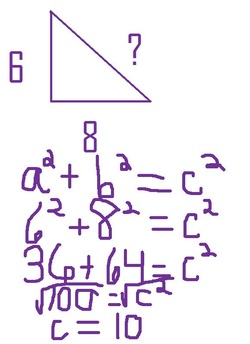Section 3-9
The Pythagorean Theorem
In this section, we learned all about the Pythagorean theorem of triangles.
What is the hypotenuse of a triangle? What are the legs of a triangle? What in the world is the Pythagorean theorem????
Look at the blue lines of the triangle. The lines both intersect each other at a 90 degree or right angle. These lines are the legs of the triangle. The leg of a triangle is one of the sides that make up the right angle in a right triangle.
The orange line is not the leg of the triangle. Instead, it is the hypotenuse. The hypotenuse of a right triangle is the side opposite of the right angle. It is also the longest side of the triangle.
Once you know the sides of the triangle, you can plug in the numbers to the Pythagorean theorem. The Pythagorean theorem is the relationship of the lengths the sides of a right triangle. The formula is in blue and orange to help you know where the sides go in the equation. Let’s try an example:
In class we just competed section 3-6. One thing we learned was how to define a variable in terms of another. To solve this problem you have to decide which unknown quantity the variable will represent. Then you have to show the other quantity in terms of that variable. Another thing we learned is dealing with consecutive integers. First you have to define a variable before describing the equation in words. Make a variable the first unknown integer and then define the other numbers in terms of that first unknown integer. Last but not least we learned how to solve problems with same direction travel, opposite direction travel, and round trip travel. The first step is to define the missing variables in the problem. Then you have to create a table to relate the numbers that includes rate time and distance because rate times the time equals the distance. You then write out and solve the equation to get your final answer.
In Chapter 3-6, you have to remember a few things. A) you must always define variables prior to writing your equation and B) you should always start with some sort of formula. So, first of all, if you start by defining a variable, it will make the problem much easier. By doing so, you know exactly what you are looking for, plus it makes it easier when finding multiple numbers by using one variable. Second, it is helpful if you start with a formula. Even writing out the words of what you are looking for can be helpful. That way, you know you plug in the right numbers, to ensure that you get the right answer. Hope this helps!
When reviewing Section 3-2, I realized how important it is to remove all decimals and fractions. To remove decimals, you simply multiply the number by the amount of spaces that come after the decimal. To remove fractions, you multiply every term in the equation by the least common multiple. We also realized that fractions and decimals require careful work and attention.
In chapter 3-2 we learned about how to get rid of fractions and decimals in an equation. Also, we learned the steps for solving a Multi-step equation. First, you clear the equation of fractions and decimals. Second, you use the distributive property to remove parentheses on each side. Third, you combine like terms. Fourth, you undo any addition and subtraction. Lastly, you undo any multiplication and division. To clear the equation of fractions you find the common denominator of the two fractions, and then you add the numerators of both. To clear the equation of decimals you have to multiply both sides by a power of 10.
In lesson 3-2 I learned about how to solve multi-step equations. For the simpler multi-step equations you need to first eliminate the fractions you have on each side of the equation. Then you should combine the like terms on either side of the equation, which may involve using the distributive property. Next you should undo the addition or subtraction on either side of the equation. Once you have done this you should undo all of the multiplication or division in the problem. If you have an equation with fractions you should then use the method of adding fractions or multiplying the fraction by a number to clear the fractions. If you have and equation that happens to have decimals you can multiply all the numbers in the equation by a power of ten that fits the problem.
I learned a lot by completing section 3-2. One thing I learned was to always copy the full problem into my notebook so I can look at it and not make any mistakes copying. Another thing I learned was always write the variables in cursive so that I don’t mistake ones like t for an addition sign, etc. The problem’s taught me that they aren’t always easy and I may have to reread it several times over until I understand it. One thing I know from before that still stands true is to ALWAYS check your work.


 RSS Feed
RSS Feed